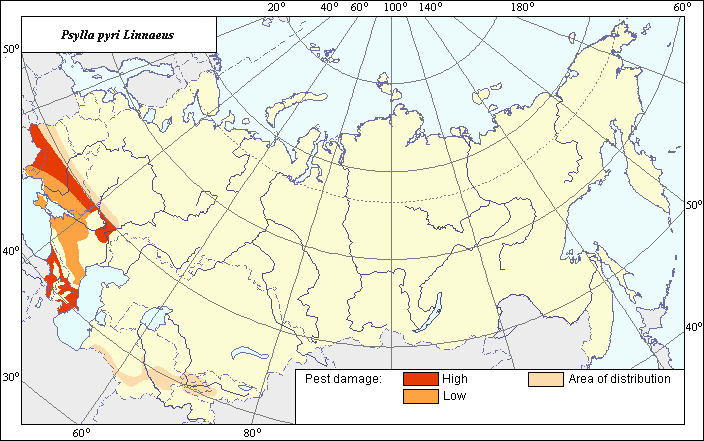Pests
Area and damage zones of Psylla pyri Linnaeus
 Object description Download GIS-layers
Object description Download GIS-layers
Authors:
Specialist-biologist M.N. Berim,GIS-specialist M.I. Saulich.
Date of creation:
4.03.2005.Scale:
1:20 000 000.Accuracy of map:
Map was created based on materials of map of natural scale 1:33 000 000.Projection:
"Alber's Equal Area Conic", 9, 1001, 7, 100, 0, 44, 68, 0, 0.Basic contents:
Vector map. Area of species distribution is shown by polygons. Zones of pest damage are shown by polygons.Accuracy of classifier:
The insect area is divided into zones of high and low damage according to published materials. The zone of high damage includes regions that are characterized by pest numbers on pear of 25 and more insects on one flower rosette; the zone of low damage is characterized by pest numbers from 3-4 (economical threshold) to 24 insects on one rosette.Method of map production:
Scientists were given maps with boundaries of Oblasts and arable lands. After reviewing historic literature, species distribution was hand drawn on maps. If data were on the Oblast-level, distribution is on the Oblast level. In some cases, Oblast.s are further refined by boundaries of the Arable Land Map (Koroljeva et al., 2003). Hand drawn maps were scanned, georeferenced and vectorized. The area and damage zones of P. pyri have were determined according to the following sources: Tvalavadze (1950), Mitrofanova (1951), Alikhodzhaev (1954), Esipenko (1962), Poddubnyi et al. (1967), Simonyan (1968), Chkhaidze (1970), Shalamberidze (1973), Linnik (1973), Lazarev (1979). The materials of VIZR expeditions were also used. The borders of the different zones of harmfulness were determined according to criteria published by the following sources: Alikhodzhaev (1954), Shchegolev (1960); Vasil'ev et al. (1973), Osmolovskii & Bondarenko (1973), Migulin (1983). The northern border was determined according to the following published materials: Shaposhnikov (1964), Vasil'ev et al. (1973), the data of VIZR expeditions, and data from a suction trap. The results of the analysis of host (pear- trees) spreading was used according to the atlas of the USSR vegetation, taking into account the temperature preference of this insect. The vector map of distribution of fruit-trees within the territory of the Former Soviet Union (Tochenov, 1984) and the northern border of wild pear vegetation (Danilevskii & Kuznetsov, 1968) were used for the correction of the borders of damage zones.Reference citations:
Alikhodzhaev D. 1954. The pear psylla. In: Bibikova A.F., ed. Proceedings of Fruit-berry Institute. N. 20. Tashkent: Fruit-berry Institute. 95-8 p. (In Russian)Chkhaidze T.A. 1970. The pear psylla - Psylla pyri L. in East Georgian conditions. In: Kanchavelli L.A., ed. Proceedings of Georgian Plant Protection Institute. N. 22. Tbilisi: Georgian Plant Protection Institute. 125-6 p. (In Russian)
Danilevskii A.S., Kuznetsov V.I. 1968. Tortricidae, tribe Laspeyresiini. Moscow-Leningrad: AN SSSR. 636 p.
Esipenko P.A. 1962. The pear psylla. Zashchita rastenii, 10: 53-4. (In Russian)
Koroljeva IE, Vilchevskaya EV, Ruhovich DI. 2003. Digital Arable Land Map. Laboratory of Soil Information of the Dokuchaev Soil Institute, Moscow, Russia [Based on: Yanvareva LF. (ed.), Martynjuk KN., Kisileva NM. 1989. Map of Land Use, Faculty of Geography, Moscow State University, Moscow, Russia.].
Lazarev M.A. 1979. New data on biology of pear psylla Psylla pyri L. (Homoptera, Psyllidae) in Crimea. Entomologicheskoe obozrenie, 58(1): 53-6. (In Russian)
Linnik L.I. 1973. Features of pear psylla (Psylla pyri L.) eggs distribution on tree. Vestnik zoologii, 6: 88-9. (In Russian)
Migulin A.A., ed. 1983. Agricultural entomology. Moscow: Kolos. 252 p. (In Russian)
Mitrofanova M.A. 1951. On problem of species structure and biology of pear psylla damaging in the USSR. In: Duka S.Kh., ed. Proceedings of Ukraine Institute of Fruit-growing. N. 32. Kiev-Khar'kov: Ukraine Institute of Fruit-growing. 93-108 p. (In Russian)
Osmolovskii G.E., Bondorenko N.V. 1973. Entomology. Leningrad: Kolos. 300 p. (In Russian)
Poddubnyi A.G., Vereshchagin B.V., Lazarev V.S. 1975. Pear psylla in Moldova and control measures against it. In: Vereshchagin B.V., ed. Dendrophilous insects of Moldova. Kishinev: Shtiintsa. 62-5 p. (In Russian)
Savkovskii P.P. 1976. Atlas of the pests of fruit and berry plants. Kiev: Urozhai. 207 p. (In Russian)
Shalamberidze N.Sh. 1973. The results of harmful fauna revealing on fruit cultures (apple and pear trees), study on bioecology Psylla pyri L., and elaboration of its control under Imereti conditions (West Georgia). PhD Thesis. Tbilisi: State University. 32 p. (In Russian)
Shaposhnikov G.H. 1964. Family Psyllidae. In: Bei-Bienko G.Ya., ed. Keys to the insects of the European part of the USSR. V. 1. Moscow-Leningrad: Nauka. 467 p. (In Russian)
Shchegolev V.N. 1960. Agricultural entomology. Moscow-Leningrad: GIZ sel'skokhozyaistvennoi literatury. 304 p. (In Russian)
Simonyan G.A. 1968. Biology of pear psylla and Vasil'ev psylla under Ararat Valley conditions. Izvestia sel'skokhozyaistvennykh nauk (Erevan), 2: 47-55. (In Russian)
Tochenov V.V., ed. 1984. Atlas of the USSR. Moscow: GUGK. 260 p. (In Russian)
Tvalavadze Yu.I. 1950. Materials on pear psylla study under Georgian conditions. Proceedings of Georgian Plant Protection Institute. N. 22. Tbilisi: Georgian Plant Protection Institute. 125-6 p. (In Russian)
Vasil'ev V.P., ed. 1973. Pests of agricultural crops and forest plantations. V. 1. Kiev: Urozhai. 208 p. (In Russian)

